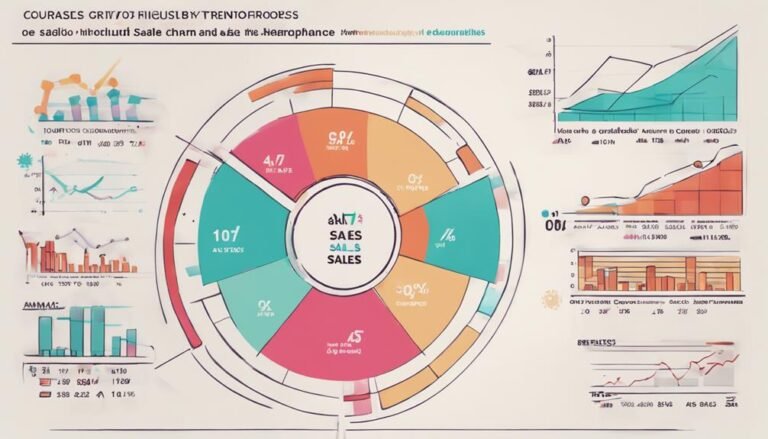How Can I Increase Course Completion Rates?
Have you ever wondered that, on average, only about 10-20% of students actually complete online courses they enroll in? Understanding this statistic can be the key to enhancing higher course completion rates. By implementing targeted strategies and fostering a supportive learning environment, you can notably increase the likelihood of your students successfully finishing the course. So, how can you turn the tide and guarantee more students reach the finish line?
Key Takeaways
- Utilize progress tracking tools for monitoring and analysis.
- Offer timely and constructive feedback for improvement.
- Implement motivational strategies tailored to learning styles.
- Create engaging course content with interactive activities.
- Foster a supportive learning community for collaboration and peer support.
Understand Student Motivations
In order to enhance course completion rates, it's important to fully explore what drives students to remain engaged and complete their studies successfully. Understanding student motivations involves delving into the domain of behavioral psychology, where incentives play a significant role in shaping student behavior. By implementing motivational strategies that cater to different learning styles, educators can effectively encourage students to stay on track and complete their courses.
Student incentives are powerful tools that can drive engagement and completion. Rewards such as certificates, badges, or even discounts on future courses can motivate students to persist through challenges and finish what they started. Behavioral psychology teaches us that positive reinforcement can shape behaviors, making it a valuable approach to boosting course completion rates.
Moreover, considering the diverse learning styles of students is essential when designing motivational strategies. Some students may thrive on visual aids, while others prefer hands-on activities. By tailoring incentives and rewards to align with different learning preferences, educators can create a more inclusive and effective learning environment that fosters course completion.
Enhance Course Engagement
To boost course engagement, incorporate interactive activities that cater to diverse learning preferences.
Boosting participation in your course can be achieved by implementing various interactive activities that appeal to different learning styles. Consider incorporating group discussions, virtual simulations, quizzes, and multimedia presentations to keep your students actively involved in the learning process.
Interactive activities not only help to increase engagement but also provide opportunities for students to apply their knowledge in practical ways. By offering a mix of activities, such as hands-on exercises, online group projects, and peer-to-peer collaborations, you can create a dynamic learning environment that encourages participation and enhances overall understanding.
Remember to vary the format and content of the activities to accommodate different learning preferences and maintain interest throughout the course. By incorporating interactive elements effectively, you can create a more engaging learning experience that motivates students to stay committed and complete the course successfully.
Implement Progress Tracking Tools
Boost your students' engagement and improve course completion rates by implementing progress tracking tools that allow them to monitor their learning journey effectively. These tools provide valuable insights through data analysis, giving students a clear picture of their progress and areas needing improvement. By incorporating progress tracking tools into your course, you enhance the user experience by empowering students to take control of their learning.
Through data analysis, these tools offer real-time feedback on performance, enabling students to identify strengths and weaknesses. This information helps students focus their efforts where needed, leading to a more efficient learning process. Additionally, progress tracking tools create a sense of accomplishment as students see their advancement over time, motivating them to continue and complete the course.
Furthermore, these tools contribute to a positive user experience by offering a visual representation of progress, making it easier for students to stay organized and motivated. Overall, implementing progress tracking tools not only enhances the learning experience but also plays an essential role in improving course completion rates.
Provide Timely Feedback
Enhance your students' learning experience by providing timely feedback throughout the course. Improving communication and encouraging participation are key elements in fostering an engaging learning environment. Here are three ways to effectively provide timely feedback:
- Set Clear Expectations: Clearly outline the grading criteria and expectations for assignments, quizzes, and discussions. When students know what's expected of them, they can better gauge their performance and understand the feedback provided.
- Utilize Multiple Channels: Incorporate various channels for feedback, such as written comments, audio recordings, or video messages. Different formats can cater to diverse learning preferences and enhance engagement with the feedback process.
- Offer Constructive Criticism: Focus on providing constructive criticism that's specific, actionable, and supportive. Encourage students to reflect on their work, make improvements, and actively participate in the feedback loop for continuous growth and learning.
Foster a Supportive Learning Community
Create a supportive environment within your course that nurtures collaboration and encourages mutual assistance among students. Peer support plays an essential role in student success. Encourage students to work together, discuss course material, and help each other overcome challenges. By fostering collaboration, you can create a strong sense of community where students feel supported and motivated to complete the course.
Building relationships is vital in establishing a supportive learning community. Encourage students to interact with each other, share experiences, and build trust. This can be done through group projects, discussion boards, or virtual study groups. When students feel connected to their peers, they're more likely to stay engaged and motivated throughout the course.
Incorporating peer feedback and peer assessment activities can also enhance collaboration and create a sense of shared responsibility for learning. Encourage students to provide constructive feedback to their classmates and work together to improve their understanding of the course material. By fostering a supportive learning community based on collaboration and trust, you can increase course completion rates and create a more engaging learning experience for all students.
Conclusion
So, how can you increase course completion rates?
By understanding student motivations, enhancing course engagement, implementing progress tracking tools, providing timely feedback, and fostering a supportive learning community.
By taking these steps, you can create a more interactive and engaging learning environment that keeps students motivated and committed to finishing the course.
So, are you ready to take your course completion rates to the next level?







